Updated on August 13, 2019, to reflect more current information.
As marketers, we can put so much effort into getting our sites into Google’s organic search results that we often neglect the search data from people who have already reached our sites. Internal site search data can show you what your target audience wants to read, what they have trouble finding, and, most importantly, which search phrases have the most conversion intent.
It requires a brief bit of set-up and some understanding of what to look for in the data, but it can be massively valuable in improving your site for existing users and helping you reach new users.
Getting Site Search Data Flowing
To set up this data on your site, go to your internal search function…
…and search for literally anything:
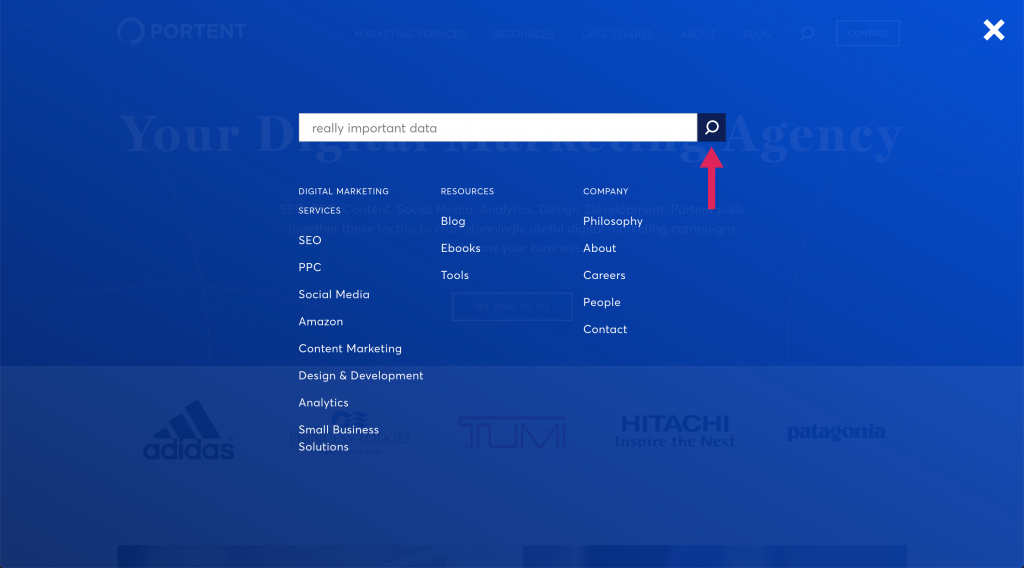
Once you get to the search results page, look for what you searched in the URL parameters. In our case, it shows up in the addsearch parameter. Copy this parameter for later.
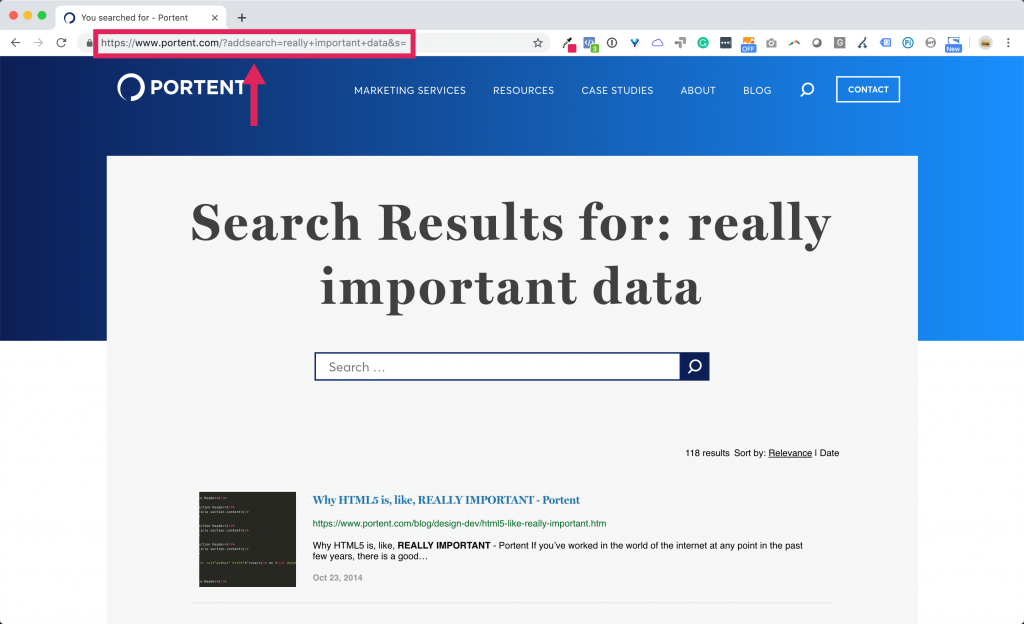
Open up your Google Analytics Admin (1) and go to View Settings (2) to access the site search settings.
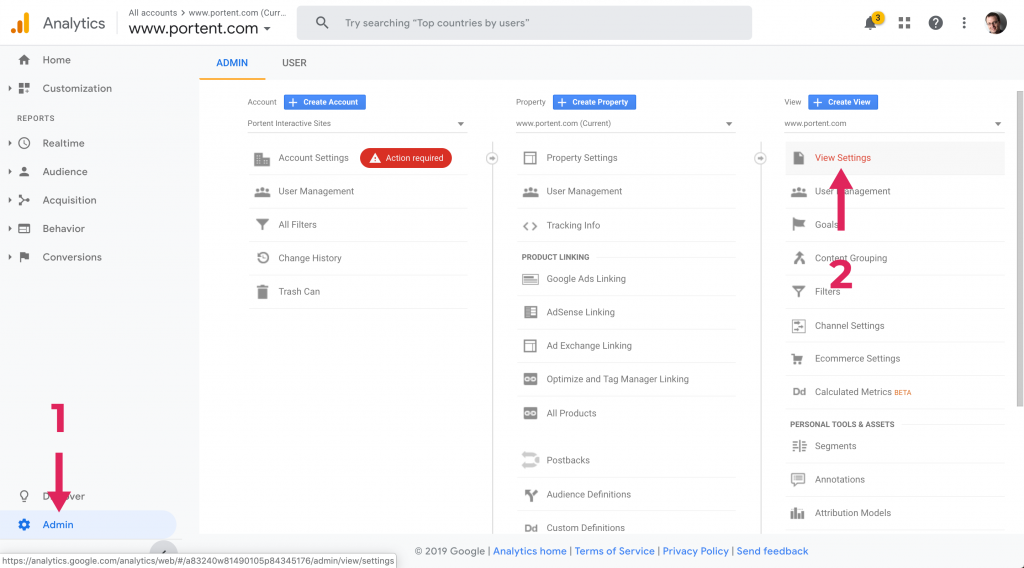
Flip the Site Search Tracking toggle to “ON” and plug in the query parameter you copied under it.
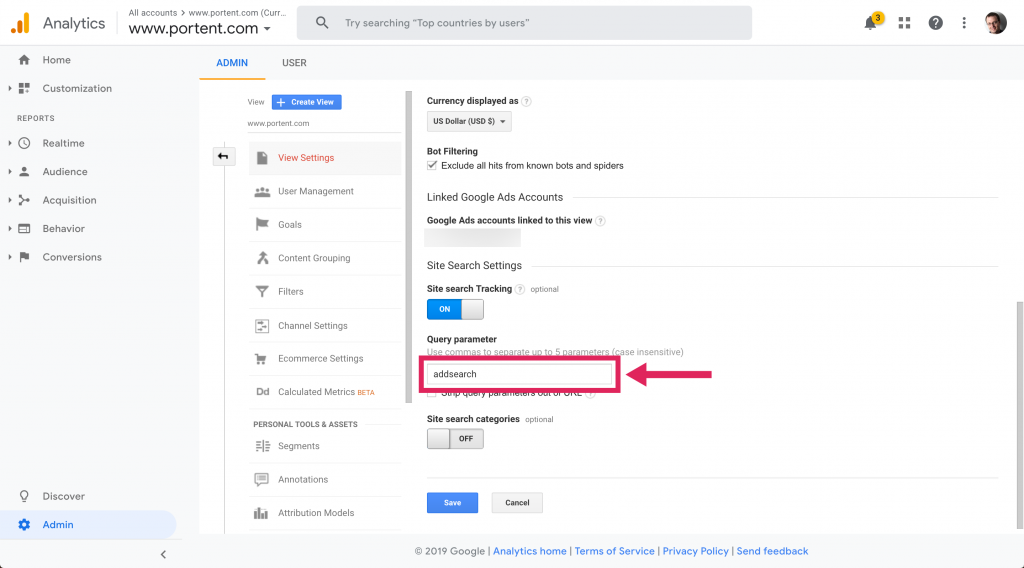
Unfortunately, this setting isn’t retroactive, but it will start collecting site search data in the Behavior > Site Search section of Google Analytics from here on out.

What the Site Search Reports Look Like
Once the data starts flowing, there are several ways Google’s canned site search reports allow you to slice the data for better insights.
Behavior > Site Search > Usage
The first is simply segmenting those who perform a search vs. those who don’t and allowing you to compare a range of engagement and conversion metrics under each of those lenses.
This can give you a general feel for how effective your internal search mechanism are at helping people find what they need and complete objectives on the site.
In our case, site searchers convert at over 6x higher than those who don’t search!

Behavior > Site Search > Search Terms
The next piece is the nitty-gritty: what are people actually searching for? Although the Top 10 may indicate some broader trends, I recommend getting all search terms out into Excel and grouping them into categories of similar searches. For us, SEO-related topics (“seo” and “serp”) and searches around our tools (“title generator” and “content idea generator”) would be worthwhile groups.
One thing to keep in mind: you’ll get a much larger range of long-tail searches with only one unique search than you will short-tail searchers with lots of unique searches. So it’s important to bundle performance across a range of similar searches in order to make the data more meaningful to act on.
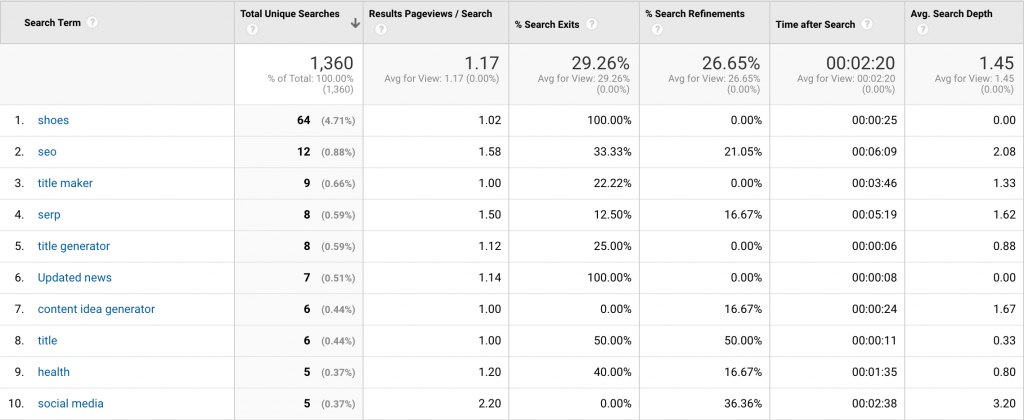
Behavior > Site Search > Search Pages
The last report in the section gives you an idea of where people are on their site journey when they’re getting lost. A high percentage of Search Refinements and low Time after Search can be indicators that the page they started searching on isn’t effectively showing folks where to go next or answering their questions in terms of navigation.
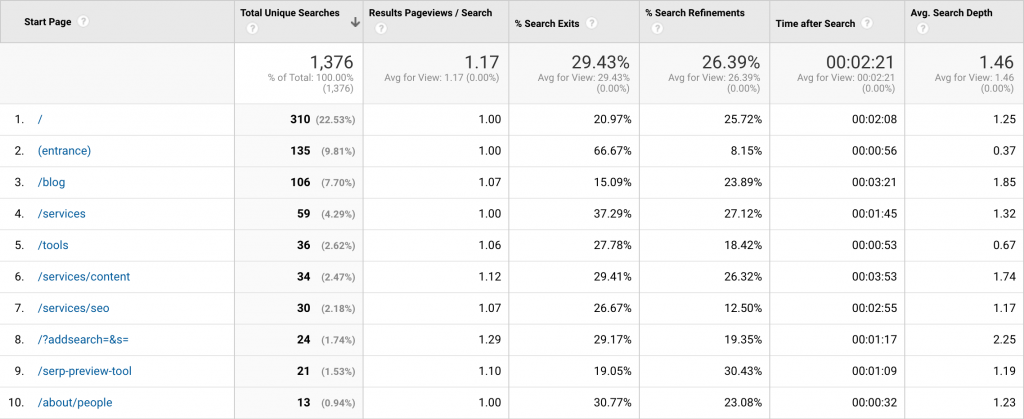
What to Do with the Data
This data, like any marketing data, can be massively overwhelming when you start collecting it over long stretches of time. But focusing on a few important things can help you make the most of it.
Content Ideas
Pretty obvious, right? Visitors searching for content that doesn’t exist on your site is a one-stop-shop for ideas your content team can work on creating. We had a lot of people searching for “shoes” in our data, probably because of this old post we did on Shopify SEO that included a ton of examples around shoes.
Maybe they want to come back to that post specifically? Or maybe we just have a lot of apparel brand marketers looking for all-around marketing advice now? In any case, it will help us create better assumptions about our target audience and what kinds of posts get them reading.
Reorganize Site Navigation
Another avenue for exploration is re-working your nav based on what gets searched for most often on the homepage.
Our site search data showed a high concentration of folks looking for specific tools we built in the past. That link is nested under our “Resources” navigation menu, but perhaps we’re making people interested in our tools work too hard to find it there?

Retargeting Audiences
But the most powerful way you can use this data is to generate audiences based on specific site search phrases who haven’t converted yet and reach back out to them with very targeted offers in Google Ads.
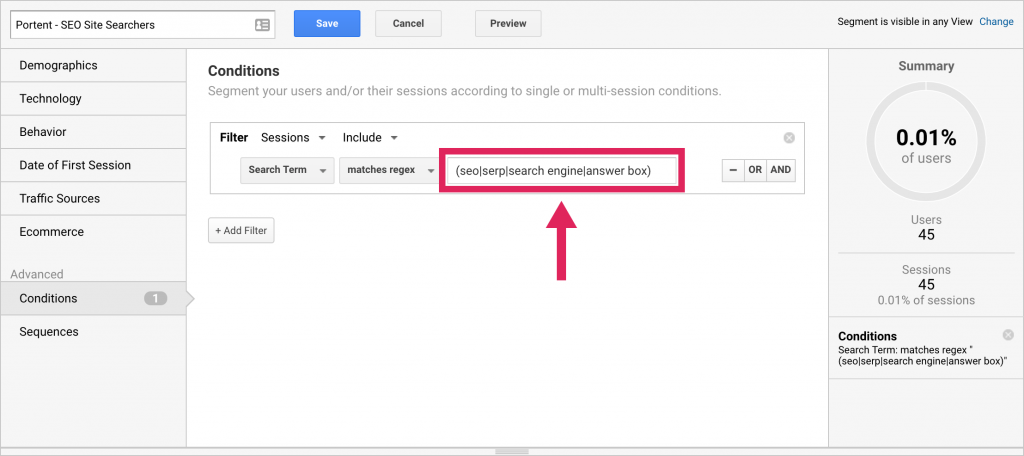
With this segmentation and audience-building method, you don’t have to hope somebody will come back to the site after you’ve optimized for site search experiences. You can actively pursue them and bring them back to specific pages that they might not have seen on their last visit.
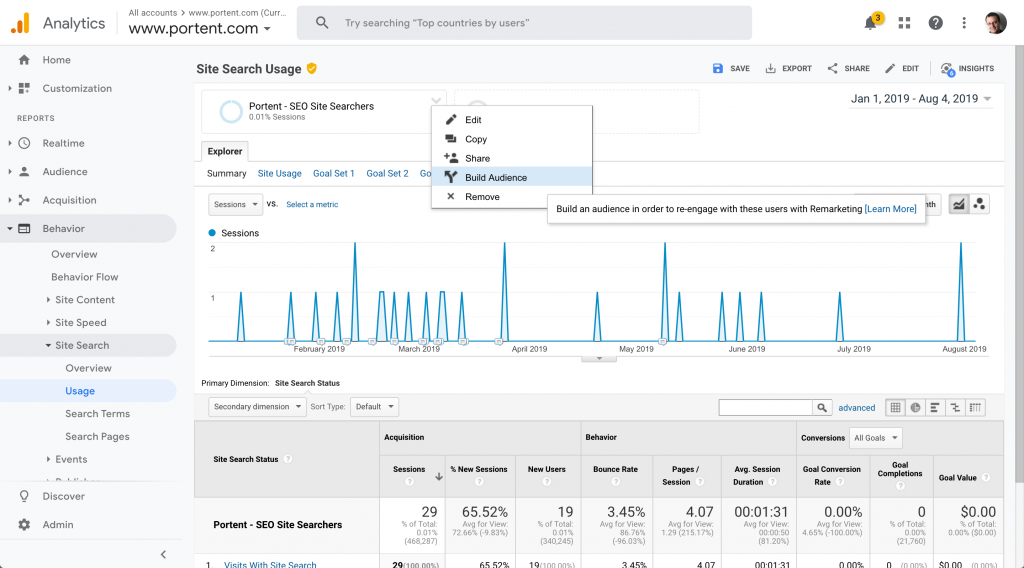
While focusing on organic search results is important to help grow the number of new visitors to your site, don’t forget about those individuals who have already discovered your product or brand. Hop into site search data today and see what you can learn about the visitors you have and learn what they might tell you about the visitors you want.










Google Analytics Site Search is active now
Finally, Google Analytics has enable site search and I played with it a little bit on one of my clients sites – I'll check in a day or so to see if I set up the website profile correctly to…
I just starting playing around with the new Google Analytics site search myself and already have some troubleshooting issues with it.
One question I have is does this work for websites that don’t have a query parameter in the URL that signals the search term? For example, you are on a site and the search page (they don’t have a search box, they have a link to the search page which then has search box) is example.com/search/, you then enter in a term into the search box like desks for example and the resulting search results page is example.com/search/index.php. As you can see, no query paramter, does this mean the site search won’t work for this site? I have another site where if you search on the home page, you get a nice URL where you can see the query parameter: http://www.example.com/catalog/shop/listpro…1&pr=tables, but if you search from anywhere else on the site you will get a URL that looks like this: http://www.example.com/catalog/shop/listproducts.asp.
I am also seeing in the Destination Pages report (exit) as one of my destination pages. Does this mean people are exiting from another page; but then why it would be listed here separate as another page? I am also seeing (entrance) in my Start Pages report which leads me to a similar question to the one I had for (exit), is this entrances to the site? I don’t get that one because even if a page was an entrance wouldn’t their be a URL for that page??
Lastly I am seeing my no results returned page as my top Destination Page and my top Start Page which sort of makes a little sense but 620 uniques searches led to this page and it has %0 search exits which doesn’t seem to fly. This doesn’t seem to makes sense to me.
Anyone else having issues or have answers to these questions? It is a new and exciting feature and I’m sure testing will help answer some of these but Google’s help section isn’t very “helpful.”
Hi Jesse,
Regarding pages that don’t have a search term in the query string: The page you’re describing probably submits the search phrase in the form scope. If you either switch the form to use ‘get’ instead of ‘post’, or just add the form variable to the query string, you’ll be able to track it.
The (exit) page means that folks saw the search results page and then exited your site.
If you can send me a screen capture for the top destination page report I might be able to figure that one out…
Ian –
I appreciate the reply and the help; hard to find either of those!
You mentioned “you either switch the form to use ‘get’ instead of ‘post’, or just add the form variable to the query string,” I’m not a programmer by any means but I think I understand what you mean. I took a look at the code for the search form and found this: <form name=â€search form†action=â€/search/index.php†method=â€postâ€> <input class=â€textfield†type=â€text†name=â€findtext†maxlength=â€400â€> <input class=â€button†type=â€submit†value=â€searchâ€>. So what would need to be changed here in order for this to work?
For the (exit), that makes sense to me now, people search on a start page, see the results, and then leave right from the results page signaling an (exit) page…..does that mean when you click on the (exit) page and you see all of those keywords, are those the keywords that triggered results pages and the exit? The (entrance)…that still eludes me.
Sure I can send a screen capture, shall I email it?
Thanks for your insight!
Hi Jesse,
For the form, you’d want to change the ‘method = post’ to ‘method = get’.
Once you do that, you’ll want to use ‘findtext’ as the query string in Google Analytics.
PLEASE NOTE that this will depend on how /search/index.php is set up. If it’s built to use a query string variable or form variable, it’ll work fine. I recommend you test it after you change it. Worst case, you can change it right back.
I believe the (entrance) means someone landed directly on your search page.
No sales pitch here, but if you’re in a time crunch my agency IS a Google Authorized Analytics Consultant, and we do offer hourly support…. 🙂
Ian,
I appreciate all of your commentary on these issues, it is extremely hard to find help real-life, technical help with this and I have already subscribed to your blog and added it to my reader. I enjoy your posts and your advice and will definitely keep you in my mind for future consulting!
Would you like for me to still send you that screen capture to quell your curiousity 😉
Thanks again
How are you doing? Thank you for this great info. I am using Google Custom Search for my site. I have difficulty in setting search words log using my info from Google Custom Search service. As I am using Google, the parameter value is ‘q’. But I cannot find any info for “post” or “get” method here. I would appreciate it if you could give some tips for setting site word search log for GCS.
You shouldn’t need to find the ‘post’ or ‘get’ method. If you just input ‘q’ as the query term you should be set.
I have installed analytics code in my website but not able to see the report of same.
what might be the problem.
tknmurthy.blogspot.com
@pradeep how long ago did you install it? It can take 24-48 hours to start seeing data.
Also, make sure you’ve got the exact code that GA generated for that specific site. Otherwise you’re sending click data to a different account.
Hey Ian,
Thank you so much, why because from the past two hours I was searching for “How to know the search terms that what visitors are searching in our site using google custom search and how to track them to optimize our site”. At last I got it now.
Thanks
Sankar
Thanks for the great post, I’ve found it very helpful!